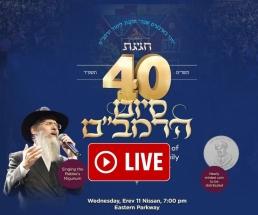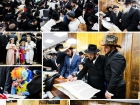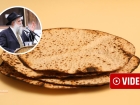Making Of A Godol: Rabbi Shneur Kotler’s Shiduch
What was the Rebbe Rayatz and the Rebbe‘s involvement in the Shiduch of Rabbi Shneur Kotler? How did the Rebbe help Rabbi Meir Ashkenazi win the Din Torah against Rabbi Aharon Kotler? ● Read more about a fascinating piece of Chabad History ● Full Story
Rabbi Yosef Chaim Shneur Kotler OBM was the Rosh Yeshiva of Beth Medrash Govoha (BMG) in Lakewood from his father’s passing on Beis Kislev 5723 until his passing on Gimmel Tamuz 5742.
While many are aware of his infamous father, Rabbi Aharon Kotler, the first Rosh Yeshiva in Lakewood, and his actions during World War II; few know of the involvement of both the Rebbe and the Rebbe Rayatz in bringing about the Shiduch of his son, Rabbi Shneur Kotler.
The following story was told over by Rabbi Moshe Ashkenazi OBM, member of Agudas Chassidei Chabad in Israel, and son of Rabbi Meir Ashkenazi OBM, a Chabad Chossid and the Rov of Shanghai:
In 1940, as a Bochur, Rabbi Shneur Kotler fled Poland for Vilna, the capital of Lithuania, where many of the Non-Chassidic Yeshivos relocated due to the World War which began. In Vilna, he became engaged to Rischel Friedman, daughter of Rabbi Malkiel Friedman of Kovno.
A short while later, his grandfather, Rabbi Isser Zalman Meltzer sent the young Shneur a visa to enter Mandatory Palestine, which saved his life, while his bride escaped to Shanghai, a haven for many European Jews who escaped the war horrors and were saved.
During her stay in Shanghai, Rischel contracted the deadly Typhus disease, which threatened her life, and was placed in isolation, where she was expected to die. However, Rabbi Meir Ashkenazi and his wife didn’t give up hope, and took the young girl under their wing, caring for all her needs, and ensuring her recovery from the deadly disease. Afterwards, she dedicated herself to helping Chabad Bochurim in Shanghai, serving as the translator for the doctors who did not speak Yiddish or Polish, translating what the Bochurim told the doctors, and what the doctors ordered the Bochurim.
The next years were filled with worries about her family left behind in Europe, and she looked forward to meeting
During the war, Rischel looked forward to meeting her groom, Rabbi Shneur Kotler, who was then in Israel. In 1946, after the war ended, and the first chance of meeting her groom came about, Rischel was smuggled in a suitcase aboard a ship to the USA, where she hoped to meet her groom and get married. During the trip she was sick, and Gershon Chanowitz, one of the Chabad Bochurim she helped, ensured she was taken care of, so she can recover.
However, one person was not happy with this arrangement; the father of the groom, Rabbi Aharon Kotler, was vehemently opposed to the Shiduch, claiming that the Typhus will cause her to die young and not be able to have children; he therefore demanded that the girl forgive her Chosson and cancel the engagement.
Rischel was devastated, and sent a message that since the Chosson is still in favor of the Shiduch, she will only cancel the Shiduch if Rabbi Meir Ashkenazi will approve.
While this was going on, Rabbi Aharon Kotler called Rabbi Meir Ashkenazi to a Din Torah, asking for the funds that Rabbi Ashkenazi used for Chabad students during the war, and demanding he pay it back. The background to this story:
During World War II, the Union of Orthodox Rabbis of the USA & Canada (Agudas Harabonim) launched a Va’ad Hatzalah to help stranded Yeshiva Bochurim flee Europe, and to support them during their travels. Since a large amount of Bochurim were stranded in Shanghai, the Va’ad Hatzalah sent money to them. The Va’ad Hatzalah fundraised from Jews of all stripes, promising to save Yeshiva students of every Yeshiva.
When the Rebbe Rayatz came to America, he launched his own Va’ad Hatzalah to save Chabad Yeshiva Bochurim, and after being approached by the Va’ad Hatzalah and promised that the Chabad Bochurim will be recipients of the funds, the Rebbe Rayatz closed his own Va’ad Hatzalah and told his donors to donate to the main Va’ad Hatzalah.
However, unbeknownst to the Rebbe Rayatz, the Va’ad Hatzalah, which was controlled by Rabbi Aharon Kotler and Rabbi Avraham Kalmanowitz (Rosh Yeshiva of Mir), made a policy to only help Bochurim of Litvische Yeshivos. They sent the money to Shanghai, addressed to Rabbi Meir Ashkenazi, with orders that the money be given to everyone aside for Chabad. Rabbi Meir Ashkenazi did not heed their directions, and used part of the funds for the Chabad Yeshiva students, knowing that the funds were given by donors who wished that Chabad students enjoy it too.
Since Japan was at war with the USA during that time, it was illegal for anyone to receive money from the USA or other enemies, and Rabbi Meir Ashkenazi risked his life every time he went to the American embassy to retrieve the money. His children relate, that he would wear Tachrichim under his clothing every time he went to retrieve the money, to ensure that if he dies, he will be buried with Kosher Tachrichim.
When this was discovered, the Va’ad Hatzalah stopped sending money through Rabbi Ashkenazi, and instead sent it directly to the Mir Yeshiva stationed in Shanghai. As a result, Bochurim from Chabad Yeshiva, Amshinov Yeshiva and Yeshivas Chachmei Lublin were left to starve, and some of them died.
As a result of the pending Din Torah, and the Shiduch crisis, Rabbi Ashkenazi went into Yechidus to the Frierdiker Rebbe and asked him what to do about these two issues. The Frierdiker Rebbe answered that he should consult with the Rebbe (then known as the “Ramash”) and do as he says.
The Ramash told Rabbi Asheknazi that he should stand strong to ensure the Shiduch takes place, saying that since they made Halachic T’naim, they have to follow through, and added that he doesn’t see a reason that she should be barren or die early. The Ramash also told him, that he should push off the Din Torah until after the wedding, and then he should claim that since he risked his life for getting the money, he was entitled to a percentage, and that this percentage he gave to Chabad Bochurim; he added that he should ask the Beis Din to determine the amount.
Rabbi Ashkenazi did as he was told, and after much convincing and even arranging a nice-sized dowry, he was able to convince Rabbi Aharon Kotler to allow his son, Shneur to marry Rischel.
After the wedding, Rabbi Ashkenazi went into Yechidus to the Rebbe Rayatz, and reported his conversation with the Ramash and the wedding. The Rebbe Rayatz spent a long time asking questions about the wedding, demanding to know every detail, including who was present, who spoke, what was served, etc. and thanked him profusely for his help.
After the wedding, when the Din Torah took place, Rabbi Ashkenazi presented his claims to the Beis Din, as ordered by the Rebbe, and the Beis Din found that Rabbi Aharon Kotler owes money to Rabbi Ashkenazi! Rabbi Ashkenazi replied, that he wants that the balance should be given to the young couple as dowry, and asked the Beis Din to ensure that it was fulfilled.
During the years that passed, Mrs. Rischel Kotler kept a connection with Rabbi & Mrs. Meir Ashkenazi, referring to them as her “parents,” and instructed her children to respect them and keep a friendship. When it was time for her son, Rabbi Yitzchok Shraga Kotler to get married, he married Miriam, granddaughter of Rabbi Meir Ashkenazi.
6262
Join ChabadInfo's News Roundup and alerts for the HOTTEST Chabad news and updates!











































What’s the point of bringing this up?
Some wording is not necessary or appropriate.
Rav Ahron Kotler was “infamous”?? He may have had a difference of opinion with Chabad and may have even been a true “misnag”, but infamous?? Rav Ahron was responsible for starting the biggest makom Torah in America!! He was a HUGE talmid chacham and tzaddik in his own right, and for you to refer to him as “infamous” is down right inappropriate and disrespectful. I’m sure the Rebbe would have accorded him all the respect and honor possible despite their differences of opinion. Shame on you!!